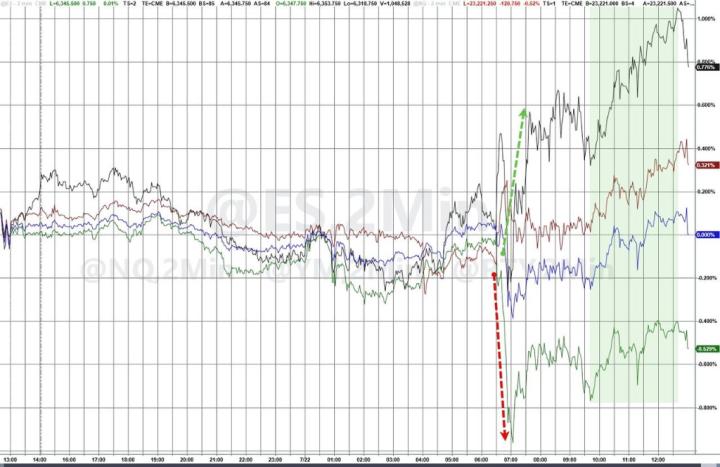Author: Arthur Hayes, Founder of BitMEX; Translation: Jinse Finance xiaozou
The highest tribute that humans can give to the universe is the joy that comes from dancing. Most religions incorporate music and dance into worship ceremonies. The "house music religion" that I believe in is not "swaying your body" in church on Sunday morning, but in Club Space at about the same time.
When I was in college, I joined a ballroom dance club. Each ballroom dance has a strict paradigm (for example, in the standard rumba, you cannot move your feet when you bend your knees). For beginners, the most difficult thing is to follow the beat and complete the basic dance steps, and most of the effort is spent on finding the beat.
My favorite Czech music is in 4/4, while the waltz is in 3/4. Once you have the beat, your ear needs to catch the first beat of the main instrument and count the instrument parts in the remaining measures. If all music was just "dong, two, three, four" like a drum beat, it would be monotonous. It is the layers of other instruments and sound effects that the composer and producer add that give the music depth and richness. But when dancing, these unimportant sounds are not helpful for accurately tapping the beat.
Like music, price charts are a manifestation of human emotions, and our portfolios dance to them. Just like ballroom dancing, decisions to buy and sell various assets must be in tune with the beat of a particular market. If you miss the beat, you lose money. Like a dancer who takes the wrong step, losing money is always embarrassing. The question is: Which instrument in the financial markets should we listen to if we want to stay elegant and prosperous?
If there is one core idea that underpins my investment philosophy, it is this: understanding changes in the fiat money supply is the most important variable in profitable trading. This is even more critical for cryptocurrencies - at least for Bitcoin, a fixed supply asset whose price rises at a pace that is directly dependent on the pace of fiat money supply expansion. Since the beginning of 2009, the flood of fiat money creation relative to the minuscule supply of Bitcoin has made Bitcoin the best performing fiat-denominated asset in human history.
The cacophony of current financial and political events is like the backing notes in a musical score. Markets continue to climb, but with serious negative catalysts that threaten to create dissonance. Should tariffs and threats of war be avoided? Or are they just minor distractions? If the latter, can we hear the guiding bass drum of credit creation?
Tariffs and wars are important, just as an important instrument out of tune can ruin an entire piece of music. But the two issues are interrelated and have no impact on Bitcoin's slow rise. US President Trump cannot impose substantial tariffs on China because China will cut off the supply of rare earths to the American Pax Americana and its vassal states. Without rare earths, the United States cannot make weapons to sell to Ukrainian President "Slav Butcher" Zelensky or Israeli Prime Minister "Bedouin Executioner" Netanyahu. The United States and China are thus caught in a deadly tango, maintaining a delicate balance at the economic and geopolitical levels. This is why the current situation - although brutal and deadly for the people in the two wars - will not have a substantial impact on global financial markets for the time being.
Meanwhile, the drum of credit keeps beating. America needs industrial policy—a euphemism for state capitalism, that dirty word: fascism. America must move from a semi-capitalist to a fascist economic system because its industrial giants are producing far less war material than is necessary for geopolitical needs. The Iraq war lasted just twelve days because Israel exhausted its stockpile of American-supplied missiles and could no longer maintain an impenetrable air defense system. Russian President Vladimir Putin shrugged off threats to step up U.S. aid to NATO because they could neither match Russia’s weapons production nor keep up with production, nor have Russia’s cost advantage.
The US also needs a more fascist economic arrangement to boost employment and corporate profits. From a Keynesian perspective, war is great for the economy. The weak organic demand of the population is replaced by the government's insatiable need to produce weapons. Most importantly, the banking system is willing to provide credit to companies because producing the goods the government needs guarantees profits. Wartime presidents tend to be extremely popular (at least initially) because everyone seems to be better off. A more comprehensive accounting of economic growth would make it clear that war is extremely destructive in terms of net benefits. But such ideas cannot win elections - every politician's primary goal is to be re-elected (if not for himself, then for members of his party). Trump, like most of his American predecessors, is a wartime president, and that is why he has put the US economy on a wartime footing. At this point the beat becomes clear: we must track the channels through which credit is injected into the economy.
In my article "Black or White" (see Jinse Finance previous article " BTC will reach $1 million if Trump's "America First" plan succeeds "), I explained how the government's profit guarantee for "critical" industries leads to the expansion of bank credit. I call this policy "poor man's version of quantitative easing", which can create a credit fountain. I predicted that this would become a means for the Trump team to stimulate the economy, and the MP Materials transaction is the first large-scale real case. The first part of this article will analyze how this transaction expands the supply of US dollar credit-this template will be used by the Trump administration to produce key materials needed for 21st century wars: semiconductors, rare earths, industrial metals, etc.
The war also requires the government to continue to borrow heavily. Even if capital gains taxes are increased as the assets of the rich appreciate as credit expands, fiscal deficits will continue to rise. Who will buy this debt? Stablecoin issuers.
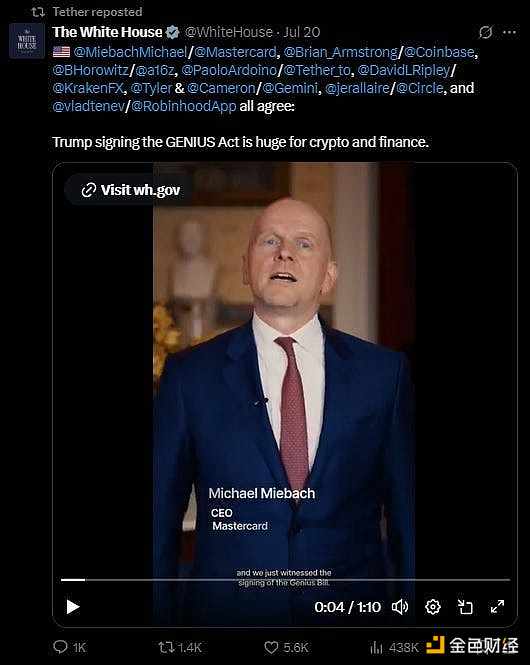
As the total market value of cryptocurrencies rises, a portion of it will be stored in stablecoins. The vast majority of these custodial stablecoin assets are invested in U.S. Treasuries. Therefore, if the Trump administration can create a favorable regulatory environment for traditional finance (TradFi) to participate in crypto investments, the total market value of crypto will surge. Then the custodial stablecoin assets will automatically increase, creating more purchasing power for U.S. Treasuries. Treasury Secretary Bessant will continue to issue Treasury bonds that far exceed the size of Treasury notes and bonds, exclusively for stablecoin issuers to subscribe.
Let us dance the credit waltz, and I will guide readers to perform this financial dance perfectly.
1. Quantitative Easing for the Poor
Central bank money printing does not create a strong wartime economy. Finance replaced rocket engineering. To correct wartime production failures, the banking system was encouraged to provide credit to industries that the government identified as critical (rather than corporate raiders).
American private enterprise is based on profit maximization. From the 1970s to today, it has been more profitable to do "knowledge" work at home while outsourcing production overseas. China was happy to upgrade its manufacturing technology by becoming the world's low-cost (and over time high-quality) factory. But it is not the $1 Nike shoes that threaten the elite rule of the "American Pax Americana" but the empire's inability to produce war materials when its hegemony is seriously challenged. This is the root of the clamor over rare earths.
Rare earths are not rare, but their large-scale processing faces huge environmental externalities and capital expenditure requirements. China today benefits from the foresight of its decision to dominate rare earth production more than three decades ago. To reverse the situation, Trump is taking a page from the Chinese economic system and ensuring that the United States increases rare earth production to continue the bellicosity of the empire.
According to Reuters, here are the key takeaways from the deal for U.S. rare earth producer MP Materials:
● The US Department of Defense will become the largest shareholder of MP Materials
● The deal will boost US rare earth production and weaken China's dominance
● The Ministry of National Defense will also set a minimum price for key rare earths
● The guaranteed price will be twice the current market price in China
● MP Materials' share price surged nearly 50% on the news of the deal
All this seems good, but where does the construction money come from?
MP Materials said JPMorgan Chase & Co. and Goldman Sachs Group Inc. would provide a $1 billion loan to build a facility that would increase its production capacity tenfold.
Why are banks suddenly willing to lend to the real economy? Because the U.S. government guarantees that this "face project" will allow borrowers to make a profit without losing money. The T-shaped chart below will explain how this transaction promotes economic growth by creating credit out of thin air.

MP Materials (MP) needs to build a rare earth processing facility and obtains a $1,000 loan from JPMorgan Chase (JPM). This loan creates $1,000 in new fiat currency and deposits it into a JPMorgan account.
MP then begins building a rare earth processing facility. To do this, it needs to hire civilian workers (Plebes). In this simplified model, all costs are assumed to be labor costs. MP must pay the workers, resulting in a debit of $1,000 to its account and a credit of $1,000 to the civilian workers' accounts at JPMorgan Chase.
The U.S. Department of Defense (DoD) needs to pay for these rare earths. The funds are provided by the Treasury Department, which must issue bonds to finance the DoD. JPMorgan Chase converts MP corporate loan assets into reserves held by the Federal Reserve through the discount window. These reserves are used to purchase bonds, resulting in a credit to the Treasury General Account (TGA). The DoD then purchases the rare earths, which becomes revenue for MP and ultimately returns to JPMorgan Chase as a deposit.
The final fiat balance (EB) is $1,000 higher than the initial JPMorgan loan amount. This expansion is due to the money multiplier effect.
This is how government procurement guarantees use commercial bank credit to build new facilities and create jobs. Although not mentioned in this example, JPMorgan Chase now lends money to civilian workers (Plebes) with stable jobs to purchase assets and goods (real estate, cars, iPhones, etc.). This creates new credit, which eventually flows to other American companies and returns to the banking system as deposits. It can be seen that the money multiplier must be greater than 1, and this wartime production will stimulate economic activity and be counted as "economic growth."
Money supply, economic activity, and government debt expand in tandem. Everyone is happy - civilians get jobs, and financiers/industrialists enjoy government-guaranteed profits. If this type of economic policy can create benefits for everyone out of thin air, why hasn't it become a common policy in countries around the world? Because it causes inflation.
The supply of human resources and raw materials required to produce goods is limited. The government's creation of money out of thin air through the commercial banking system will squeeze out the financing channels and even production capacity of other goods, eventually leading to a shortage of raw materials and labor. However, the supply of fiat money will never be exhausted, and wage and commodity inflation will inevitably follow, and those individuals and entities not directly related to the government or the banking system will eventually fall into trouble. If in doubt, you might as well look through the daily historical materials of the two world wars.
The MP Materials deal is the first example of a "poor man's quantitative easing" policy. The best part is that it doesn't require congressional approval - under Trump and his successor in 2028, the Department of Defense can simply issue guaranteed purchase orders in the course of its regular business. Profit-seeking banks will follow suit, fulfilling their "patriotic duty" by supporting companies that rely on government finances. In fact, members of Congress from all parties will be scrambling to argue why companies in their districts deserve more orders from the Department of Defense.
Given that this model of credit creation circumvents political resistance, how can we protect our portfolios from the resulting inflation?
2. Crypto Bubble
Politicians know that stimulating credit growth to boost "critical" industries will inevitably lead to inflation. The real challenge is to guide excess credit to inflate an asset bubble that will not destabilize society. If wheat prices had skyrocketed like Bitcoin has over the past 15 years, most governments would have been overthrown by popular revolutions. So governments encourage citizens - a group whose real purchasing power continues to shrink - to play the credit game by investing in inflation-resistant assets backed by the state.
Let's look at a real-world, non-crypto example: Since the late 1980s, China's banking system has created the largest amount of credit in the shortest time in the history of human civilization, and mainly channeled it to state-owned enterprises. They have successfully built the world's low-cost, high-quality factories, and now one-third of the world's industrial products are produced in China. If you still think that Chinese manufacturing is of poor quality, you might as well test drive BYD and compare it with Tesla.
Since 1996, China's money supply M2 has soared 5,000%. Civilians trying to escape credit inflation face extremely low bank deposit rates, so they flock to the real estate market - this is exactly what the government's urbanization strategy encourages. As of 2020, the continued rise in housing prices has effectively curbed people's desire to hoard physical goods. Measured by the income-to-house price ratio, housing prices in China's first-tier cities (Beijing, Shanghai, Shenzhen, Guangzhou) are already among the highest in the world.
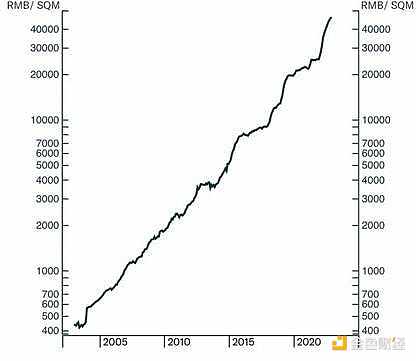
Land prices have increased 80 times in 19 years, with a compound annual growth rate of 26%.
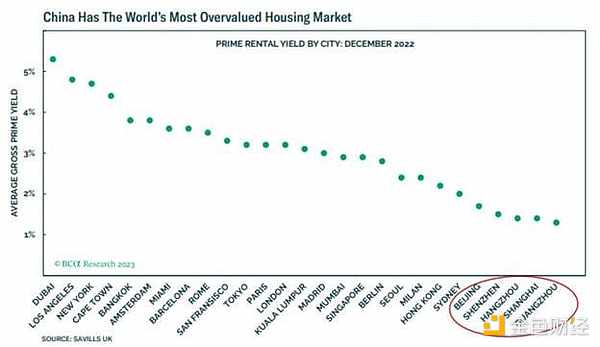
This housing price inflation did not destabilize society, because ordinary middle-class comrades were able to buy at least one apartment with loans. Therefore, everyone participated. An extremely important second-order effect is that local governments mainly finance social services by selling land to developers, who then build apartments and sell them to ordinary people. As housing prices rise, land prices and land sales and tax revenues grow in tandem.
We can perhaps conclude that the Trump administration’s excess credit growth must create a bubble to make money for ordinary people and to fund the government. The bubble that the Trump administration will create will be centered around cryptocurrencies. Before I delve into how the crypto bubble will achieve the various policy goals of the Trump administration, let me first explain why Bitcoin and cryptocurrencies will rise rapidly as the United States moves towards a fascist economy.
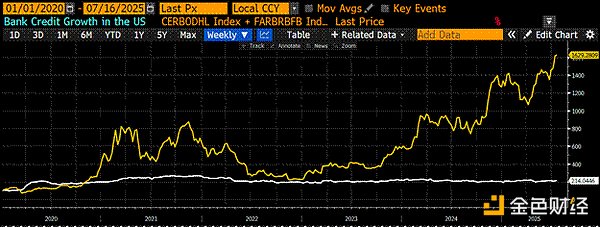
I created a custom indicator on the Bloomie platform called <.BANKUS Index> (in white). The index combines bank reserves held by the Federal Reserve Bank of the United States with the sum of other deposits and liabilities of the banking system, and can be used as a proxy for loan growth. Bitcoin is marked in gold, and both baselines are 100 basis points in January 2020. As credit doubled, Bitcoin rose 15 times - its fiat currency price is highly leveraged to credit growth. At this point, no retail or institutional investor can deny that if you believe that more fiat currency will be issued in the future, Bitcoin is the best investment target.
Trump and Bessant have also been conquered by the "orange pill (i.e. Bitcoin)". From their perspective, the most significant advantage of Bitcoin and cryptocurrencies is that the cryptocurrency ownership rate of groups that traditionally do not own stocks (young people, low-income people and non-white people) has exceeded that of wealthy white baby boomers. Therefore, the prosperity of cryptocurrencies will win support from a wider and more diverse group of people for the ruling party's economic program. More importantly, according to the latest executive order, in order to encourage all kinds of savings to invest in the crypto field, 401k pension plans are now explicitly allowed to invest in crypto assets - such plans manage about $8.7 trillion in assets. It's about to take off!
The ultimate killer move is the cryptocurrency capital gains tax exemption proposal put forward by "Emperor Trump". Trump is promoting: crazy credit expansion driven by war + regulatory green light for pension funds to enter the market + full tax exemption policy. It is simply a celebration for all!
All this seems perfect, but there is a fatal problem: the government must issue more debt to honor the procurement guarantees of the Ministry of Defense and other departments to private enterprises. Who will take over these debts? Cryptocurrency will be the winner again.
Once capital enters the crypto capital market, it usually does not withdraw. If investors want to wait and see for the time being, they can hold USDT and other US dollar stablecoins. In order to earn the income of the custodial funds, USDT must invest in the safest traditional financial interest-bearing tool: short-term treasury bonds. This type of treasury bond has a term of less than one year, has almost zero interest rate risk, and has liquidity comparable to cash. The US government can print money for free and indefinitely, and nominally there is no possibility of default. The current short-term treasury bond yield is between 4.25% and 4.50%. Therefore, the higher the total market value of cryptocurrencies, the more funds stablecoin issuers absorb - ultimately most of these custodial funds will flow into the short-term treasury bond market.
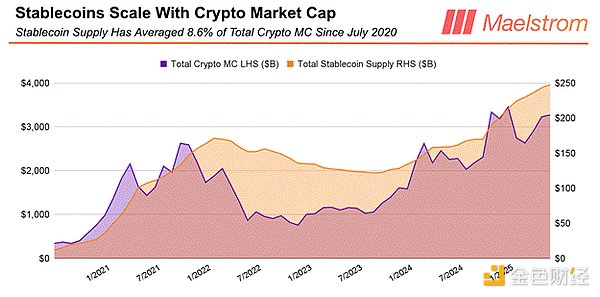
On average, for every $1 increase in the total market value of the crypto market, $0.09 flows into stablecoins. Assuming Trump successfully pushes the total market value of cryptocurrencies to $100 trillion by the time he leaves office in 2028, which is a 25-fold increase from the current level, if you think this is impossible, it only shows that your understanding of the crypto market is too shallow. By then, global capital inflows will prompt stablecoin issuers to generate about $9 trillion in short-term Treasury purchasing power.
From a historical perspective, the Federal Reserve and the Treasury Department also significantly increased the issuance of short-term Treasury bonds rather than long-term bonds in order to finance the United States' participation in World War II.
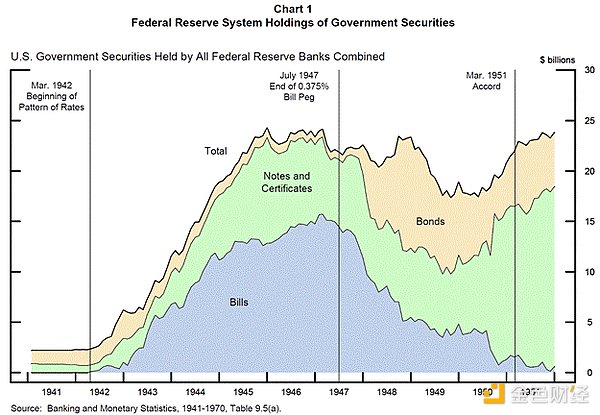
Now Trump and Bessant have completed a perfect closed loop:
1. Created an American-style fascist economic system to produce wartime materials needed for indiscriminate bombing;
2. The inflation impulse of financial assets caused by credit growth directly points to cryptocurrencies, and the price of cryptocurrencies has soared, and a large number of people have gained huge profits and feel richer. They will vote for the Republican Party in 2026 and 2028... unless there are adolescent daughters at home... but the lower class people have always voted with their wallets
3. The booming cryptocurrency market has brought huge capital inflows to stablecoins pegged to the US dollar. These issuers invest their custodial US dollar stablecoins in newly issued Treasury bonds to cover the widening federal deficit.
4. The drums are rolling and the credit lines are rising. Why don't you go all in on cryptocurrencies? Don't be scared by tariffs, wars, or various social issues.
3. Trading strategy
Simple: Maelstrom is fully invested. Because we are degens, the Altcoin market offers a great opportunity to outperform Bitcoin (the crypto reserve asset).
The coming Ethereum bull run will tear the market apart. Ever since Solana rose from the ashes of FTX from $7 to $280, Ethereum has been the most hated large-cap cryptocurrency. But now it’s different - Western institutional investors, led by Tom Lee, are now in love with Ethereum. No matter what, buy it first. Or you can choose not to buy it, and then hide in the corner of the nightclub like a sour complainer, drinking a bland beer, watching a group of people you think are less intelligent than you, splashing money on sparkling water at the next table. This is not financial advice, so do it yourself. Maelstrom’s strategy is: All in Ethereum, All in DeFi, All in the ERC-20 Altcoin driven degen ecosystem.
My year-end target price:
Bitcoin: $250,000
Ethereum: $10,000







